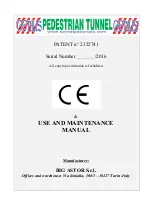
17
Dymax ECE ZIP™ Shutter User Guide
Definition of Terms
UV Curing Light Source -
a reflector housing and a power supply furnished with an appropriate bulb (burner)
for generating light energy of required spectra and intensity.
Flood Lamp System -
a set of components arranged to generate, collect, condition, and direct UV radiant
energy to perform curing of engineering adhesives, coatings, and inks in a safe and controlled process. It
includes a lamp housing and power supply and may also include a shutter, workstation, UV enclosure, Dymax
light shield, and accessories.
Lamp -
light source (bulb or burner) generating ultraviolet, visible, or infrared radiant energy from burning
matter stimulated by electrical power. A bulb or burner is usually placed into a reflector to increase light
source efficiency by collecting and directing radiant energy of selected spectra for a specific curing process.
Intensity -
a measure of light energy over the unit of surface area (usually at a specified working distance
from the bottom of a reflector housing) in W/cm
2
or mW/cm
2
. For the UV portion of light, this measure is
often called in literature “irradiance”, i.e. radiant energy arriving at a point on a surface per unit area.
Brightness, also known as Luminance -
description of energy in the visible region of the spectrum
(approximately from 400 to 700 nm) and recorded in photometric units. “Intensity” (see below) of visible light
energy is called luminance.
Luminance -
luminous flux (energy of visible light) incident per unit area, and measured in Lx (lux) or
Lumen/cm
2
.
Ultraviolet (UV) -
the invisible region of the spectrum just beyond the violet end of the visible region. UV is
divided into three spectral parts:
1.
Ultraviolet A (UV-A) - UV of long wavelength from within approximately 400 to 320 nm of the spectral
band (4000 to 3200
) - predominately produced by Dymax Flood Lamps.
2.
Ultraviolet B (UV-B) - UV of medium wavelength from within approximately 320 to 280 nm - Dymax Flood
Lamps produce some amount of their energy within this bandwidth.
3.
Ultraviolet C (UV-C) - UV of short wavelength below 280 nm (we say from 280 to 200 nm) – a large
amount of this energy is present in the sunlight.
Dose -
is irradiance integrated over time, or Irradiance (W/cm
2
) x Time (s) = Dose (Joules/cm
2
). Note: Watt is
the power that gives rise to the production of energy at the rate of 1-joule (J) per second (s).
As irradiance can be a far more significant factor in the efficiency of curing adhesives and other UV-curable
materials, the dose and spectral response can also be substantial contributors to the quality cure
performance.
OSHA 1910.145:
“Regulation of Accident prevention Signs and Tags” defines the following
headers as:
WARNING – is used when there is a hazardous situation that has some probability of severe injury.
CAUTION - is used to indicate a hazardous situation that may result in minor or moderate injury.
NOTICE - is used to convey a message related directly or indirectly to the safety of personnel, or
protection of property.




































